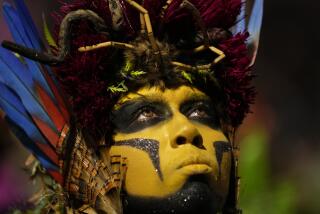Delicate Mine Removal Operation Saves Lives, Land in Northern Iraq
- Share via
SULAIMANIYA, Iraq — Ismail Ali can’t forget his final soccer game. It was Sept. 5. During the game in his Kurdish mountain village, the 14-year-old team captain stepped on a land mine and his left leg was shredded.
“It is not easy to play with one leg, is it?” Ali said during a recent interview at a hospital, turning his head to hide his tears.
Another Kurd has equally dreadful memories of a time nearly eight years earlier, when he was a private at the other end of Iraq, near the border with Kuwait.
Boya was caught up in the frenzied preparations for the Gulf War, planting land mines that Saddam Hussein hoped would blunt the impending U.S.-led onslaught that liberated Kuwait. When Boya and his 15 unit mates were done, 13,000 mines had been laid out in one night.
“I felt like a criminal, but I had no choice,” said Boya, who asked not to be identified further for fear of retribution from the Iraqi government.
He is trying to make amends: He joined a United Nations program that began last year to remove mines in northern Iraq, where the deadly devices outnumber people 3 to 1.
Ali and Boya are the twin faces of Iraq’s tragedy and hope.
Northern Iraq has 3.3 million Kurdish residents--and 10 million land mines, making the Switzerland-sized region the most densely mined area in the world. At the current rate of mine removal, U.N. officials estimate that it will take hundreds of years to clear the explosives.
“But every little bit helps,” said Faiz Muhamad, a mining removal assistant supervisor from Afghanistan.
Some of the mines date to the start of the Kurdish insurgency against the Iraqi government in 1974. Most were laid near the Iranian border during the 1980-88 war between Iraq and Iran. More appeared during factional fighting between Kurdish groups after Hussein lost control of the northern area in 1991.
Boya, like most Kurdish soldiers, deserted his Iraqi army unit when Kurds rose up after the Gulf War. He did odd jobs until he signed up as a mine remover.
“Eight years ago I was expected to kill. Now I am either saving a life or making land available to somebody. To me that is paying my dues,” said Boya, sitting in his tent in the village of Ashkawsaqa, where the United Nations has set up a new mine removal operation.
The day before, his team identified a minefield outside the village and marked the area with poles topped by steel triangles showing the skull and crossbones. The mine removers were alerted by villagers who reported the death of a dog and a donkey in the freshly plowed fields.
Now experts armed with metal detectors and other equipment will work to clean the field of mines, usually discs smaller than doughnuts buried inches under the surface.
“Mines are sleeping soldiers. They will sleep for decades and snap at you without warning,” said Dave Penson, an Australian who heads the team in Ashkawsaqa, 215 miles north of Iraq’s capital, Baghdad.
Since 1991, about 2,900 people have been killed and nearly 5,400 injured by mines in the three northern provinces of Dahuk, Irbil and Sulaimaniya, the United Nations says. It says 20% of arable land in the region is unusable because of mines.
Sulaimaniya, in a district bordering Iran, has 60% of the 2,386 minefields identified so far. Hundreds more remain uncharted.
With their land unusable, thousands of farmers have abandoned villages to live in refugee camps. Families no longer park their cars along the roads for picnics in the scenic hills.
The mine removal program owes its existence to the U.N. economic sanctions imposed on Iraq for invading Kuwait in 1990.
The money for the program--about $10 million spent so far--comes from the U.N.-approved oil-for-food program that has allowed Iraq to sell oil since December 1996 to finance humanitarian purchases. The mine removal office was set up in October 1997, and the operations began in April 1998.
The United Nations has so far trained 600 Kurds and is using 14 sniffer dogs from South Africa. The United Nations and other aid agencies also have set up five hospitals and artificial-limb centers.
Ali, the young soccer player, got a prosthetic leg in February and after a few months of physical therapy may even be able to run a bit.
“I know I can never be a striker [goal scorer] again. But never mind, I will be a defender,” he said, his round face breaking into a smile.
More to Read
Sign up for Essential California
The most important California stories and recommendations in your inbox every morning.
You may occasionally receive promotional content from the Los Angeles Times.













